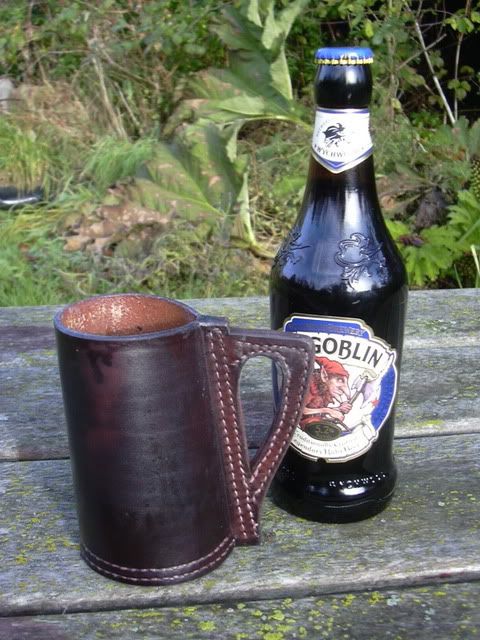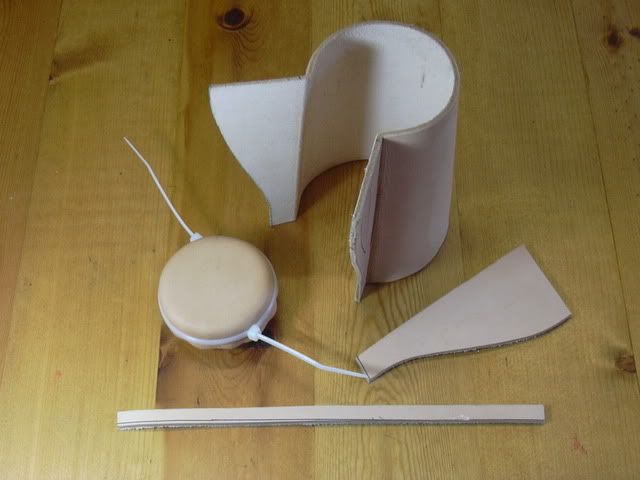 Here is something I have been thinking about doing for a while. A leather mug!
Here is something I have been thinking about doing for a while. A leather mug!I am not a big beer drinker but I do enjoy the odd one now and again, such as this Hobgobblin.
I thought it would taste even better in a traditional leather "mug" accompanied by the smell of beeswax and it does. Nice to think it's not something that's been mass produced in China like most things today.

These are the bits of leather necessary to make the mug. Then you only need some linen thread, two harness needles, a bit of beeswax for the thread, and a bit of time...

Then, when the thing is sewn together, you need to wax it. I heated the beeswax in a double boiler in the kitchen.. Something you want to do when you wife is in London!!!
My boiler is not big enough so I could not dip the whole mug into it. I had to improvise by pouring the liquid wax into it with a ladle then poured it out again once bubbles stop appearing in the liquid wax. The wax was ladled on the outside of the mug. I used a heat gun to finish melting the outside wax and help it sink into the leather.
Once cooled the mug is hard as steel. Just don't put hot liquids into it.
Cheers!
Next thing on the list is a leather bottle, or a flask.

Good post, I would love to have one of these. I feel however that this project is a lot harder than appears from reading your account.
ReplyDeleteOne assumes the Black Jack is dished at the bottom and one would have to make two lines of holes with an awl around this base. I feel this will not be easy.
You mentioned bubbles, which makes me think that the wax was very hot and it cooked the leather, because you also mention that it is hard.
The originals were supposed to be very hardy and stand up to a lot of banging about, I wonder if this was due to them being plyable? Hard ? Or sealed with pitch instead of beeswax?
Anyway, love the look of your leather mug,& am tempted to try making one in the same manner.
Regards, Le Loup.
Hi Le Loup.
ReplyDeleteActually, it's not too difficult to do this. I am going to write a tutorial showing how it's done ( well, on how I did mine!)
The beeswax is melted in a double boiler, so it can't get hot enough to catch fire or burn & shrivel the leather. The air bubbles I mentioned come out of the leather when the liquid wax is absorbed by the leather. Once the wax has cooled completely, the leather/wax becomes quite hard but still retain some suppleness which makes it very hardy as you rightly put it. Beeswax was used but was very expensive, hence the use of Natural pine tar pitch which was cheaper. I haven't used pitch yet so can't give you a comparison, but I believe it solidifies harder but more brittle than beeswax.
Thanks Woodman, I look forward to your tutorial. Yes I think I like the idea of beeswax better than pitch.
ReplyDeleteRegards, Le Loup.
Hi Joel, good to hear from you.
ReplyDeleteMy costrel does indeed hold 1 1/2 litres. You can get smaller versions but I think this size is just right.
Difficult to explain size because it is not just round or square. I will give you the dimensions of the ends, and the OVERALL size is the actual shape. Does that make sense?
5 1/4" wide 6" overall
5" high 7 1/4" overall (to top of neck).
6" long.
Regards, Le Loup.
All measurements are outside measurement, but see how the sides of the costrel bulge. From one outer bulge side to the other is the OVERALL measurement. The height is also taken at the ends of the costrel, but the OVERALL height is from the bottom to the top of the spout (not including wood plug).
ReplyDeleteThe thickness of the leather is 3/16" (three sixteenths of an inch).
PS. There are three(3)layers of 3/16" leather as a welt has been added all round, ends and top.
Regards, Le loup.
Beg your pardon Sir, but if you add 3 layers of 3/16" leather that would equal 9/16, from the photo above, the thickness on the mug is no where near 9/16"?? Might you kindly remeasure. Also, do you have an opinion as to the stitches per inch.
DeleteThanks
Jack
I cut out a mug last night from .060" leather, 3 x .060 is @ 3/16 = .1875", where as 9/16" is over 1/2" thick. something doesn't add up here, on the hand I could be wrong.
Are there different grades of Beeswax??
Thanks for your time Le Loup and Woodman.
Well done on those mugs!
ReplyDeleteLooking foreward to more of your posts in 2010.
ReplyDeleteRegards, Le Loup.
Woodsman ...gott'a ask what you used for the bottom, just a piece of leather or a flat of wood
ReplyDeleteI used leather, the same as the rest of the mug, sewn to the side of the mug.
ReplyDeleteThis is awesome i am going to be doing this as soon as i can get some bees wax. Any tips?
ReplyDeleteEbay in the US is where I have purchased beeswax in the past. Ebay UK might have it.
Deletehow many stitches per inch? did you use the waxed corded string?
ReplyDeleteLe loup Mentioned that there 3 layers of 3/16, could i use a 9/16?
3/16=.1875, ... X 3 = .5625 - 9/16
are you saying to use belt weight leather? the long strip-is that a gusset brace??? from the top all the way around to the other side?
thank for helping me.
Jack G
a few more question:
ReplyDeletecould one use waxed polyester thread?
what color of beeswax, white or yellow?
Thanks
jack